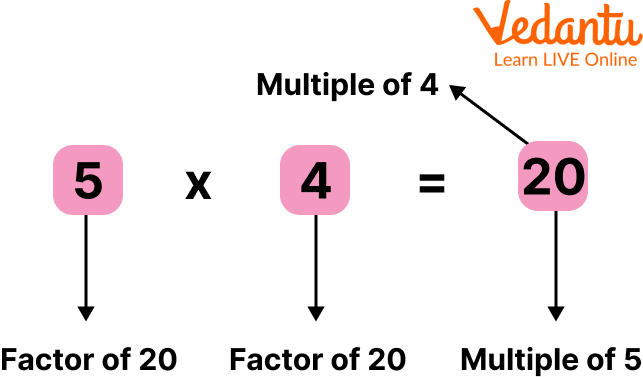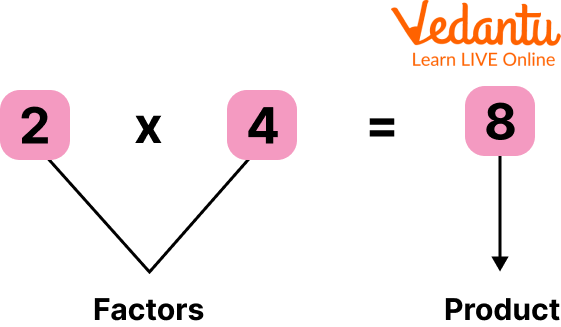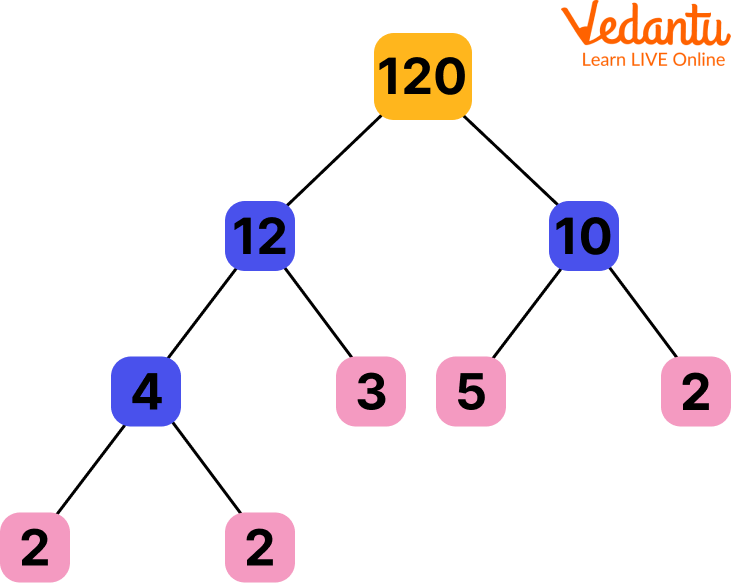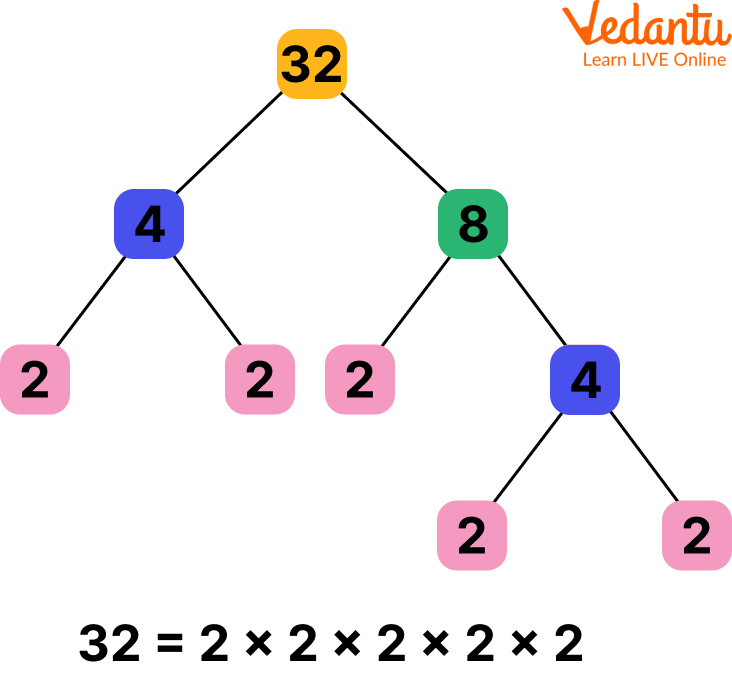




Step-by-Step Methods to Identify Factors
The concept of factors and multiples are interrelated in Mathematics. Factors are the numbers that divide the given number exactly with no remainder left. Here in this article, we will learn what are factors, how to construct a factor tree, and much more.
The factors in simple words are the numbers (dividend) when exactly divided by any number (divisor), then the divisor is said to be a factor of the number i.e dividend. Every number will have '1'as a common factor and for any prime number, '1' and the number itself will be its factors for sure.

Factors and multiples
Factor Tree
A factor tree is a method of factorizing a number that is similar to the way in which the branches of a tree are split. Every branch of the factor tree is split into factors and once the factors cannot be factorized further, the branches come to an end, the final factors are circled and are considered to be the prime factors of the given number.
How to Solve Factor?
Factors are the numbers that divide the given number exactly with no remainder left.
Now let us see how to solve factor questions.
Let us consider the number 8,
$8 =1 \times 8$
$=2 \times 4$
Hence, 8 is a product of 1 and 8 and 2 and 4 . As a result, factors of 8 are 1,2,4 and 8.
Hence, "When finding or solving a factor question, we only consider positive numbers, whole numbers, and non-fractional numbers". Decimal and negative numbers are not considered while solving the factors of the numbers.
Also, the general rule to define factors is, "When we multiply 2 whole numbers, the numbers we multiplied are the factors of the product. Because they are divisible by the product".
In general, if ' $a$ ' and ' $b$ ' are multiplied to give 'ab' we say that ' $a$ ' and ' $b$ ' are the factors of 'ab'.
For example, $7 \times 5=35$. Hence, 7 and 5 are the factors of 35 . Because no remainder is left when $35 \div 7$ or $35 \div 5$, the remainder is zero.
$2 \times 3=6$
Hence, 2 and 3 are the factors of 6 because no remainder is left when $6 \div 2$ or when $6 \div 3$.

How to find Factors
Properties of Factors
'1' is the smallest factor a number can have.
Every number is always a factor in itself.
The number of factors a number can have is always finite.
Things to Remember
'1' is not a prime number, hence it will not appear in the factor tree, but 1 is a factor of all numbers.
Factors of a number must be represented with multiplication symbol(×) and not addition while we represent it in index form.
The multiplication of factors of a number must always give the number which was factorized.
The last branch of the factor tree must always contain a prime number.
A factor tree will not contain decimals as we are working with positive factors only.
The factor tree of a number is not unique but the product of prime factors is unique.

Factor tree
Steps to Construct a Factor tree
Here are some steps to make your factor tree practice easy.
Setp 1: Write the number at the top of the factor tree in a rectangular box.
Step 2: Fill in the branches with factors of the given top number.
Step 3: Factorized the branch number till we get a prime number in the end.
Step 4: Denote the prime number in the last with a circle.
Step 5: Write the solution in the indexed form separately.
Now, let us do some factor tree practice to make the concept easy for kids.
For example, express the factor of 51 in the form of the factor tree.
Here, we have $51=3 \times 17$
Hence the factors of 51 are 3 and 17 only.
Now we write 51 in a rectangular box and 3 and 17 as its branches. Both 3 and 17 are prime numbers. Hence we highlight both 3 and 17 in circles. We can say that 3 and 17 are prime factors of 17.
So, "When there is a prime number at the end of the factor tree we say that we have constructed a prime factor tree".
And, when there are no prime numbers at the end of the factor tree, it means it will be more factorized, we will have to split the branches until we receive prime numbers at the end of the branches.

Factor tree example
Solved Examples
Q 1. Find the factors of 27.
Ans: We have $27=3 \times 9$
Hence, the factors of the number 27 are 1,3,9, and 27.
Q 2. Find the factors of the numbers 55 and 81 .
Ans: We have $55=11 \times 5$
Hence, factors of 55 are 1,5,11, and 55 .
Also, we have $81=3 \times 27=3 \times 3 \times 9$
Hence, factors of 81 are $1,3,9,27$ and 81.
Practice Set
Q 1. Find the factors of 20.
Ans: 1,2,4,5,10 and 20
Q 2. Find the factors of 81, 55,190
Ans: Factors are as following:
81= 1,3,9, 27,81
55= 1,5,11,55
190= 1,2,5, 10,19,190
Q 3. What is the smallest factor of 51?
Ans: 1
Summary
So in this article, we learned about factors. A number or algebraic expression which divides another number or expression in a way such that no remainder is left is called a factor. For example, 2 and 5 are the factors of 10 because 10÷2=5 and 10÷5= 2 exactly. We also saw how to make a factor tree to solve examples efficiently. Factors play an important role in day-to-day life. We tried to list factor questions that would help students to practice. Factor tree practice will help kids to factorize any numbers and find their prime factors. We understood how to solve factors and how to construct a factor tree.
FAQs on What Are Factors in Maths?
1. What is a factor in mathematics?
A factor is a whole number that divides another number exactly, leaving no remainder. When two or more numbers are multiplied to get a result (called a product), each of the numbers being multiplied is considered a factor of that product. For example, in the equation 3 × 8 = 24, both 3 and 8 are factors of 24.
2. How are factors and multiples different from each other?
The main difference lies in their relationship to a number. A factor divides a number, while a multiple is a result of multiplying a number.
- A factor is a number that can divide another number exactly. Factors are always less than or equal to the number itself, and they are finite. For example, the factors of 12 are 1, 2, 3, 4, 6, and 12.
- A multiple is the result of multiplying a number by an integer. Multiples are always greater than or equal to the number itself, and they are infinite. For example, the multiples of 12 are 12, 24, 36, and so on.
3. Can you explain how to find all the factors of a number, for example, 36?
To find all the factors of 36, you can identify all the pairs of whole numbers that multiply together to give 36. A systematic way is to check numbers starting from 1.
- 1 × 36 = 36
- 2 × 18 = 36
- 3 × 12 = 36
- 4 × 9 = 36
- 6 × 6 = 36
By listing all the unique numbers from these pairs, you get the complete set of factors. Therefore, the factors of 36 are 1, 2, 3, 4, 6, 9, 12, 18, and 36.
4. Why can't factors be decimals or fractions?
The definition of a factor is rooted in the concept of exact division within the set of whole numbers (or integers). A factor must divide a number completely, without leaving any remainder. If decimals or fractions were allowed, any number could technically divide another, which would make the concept of distinct factors meaningless. The rule ensures that factoring is about breaking down a number into its whole-number components.
5. What is the relationship between factors and multiplication?
Factors and multiplication are inverse operations. Multiplication combines numbers (the factors) to create a new number (the product). Factoring, on the other hand, breaks down a product into the original numbers that were multiplied to get it. For example, multiplying the factors 7 and 5 gives you the product 35. Conversely, when you find the factors of 35, you are identifying numbers like 7 and 5.
6. Which number is a factor of every other number?
The number 1 is a universal factor; it is a factor of every whole number. This is because any number divided by 1 results in the number itself, with no remainder. Additionally, every number is always a factor of itself. Therefore, every number greater than 1 has at least two factors: 1 and the number itself.
7. What is the importance of understanding prime factors?
Understanding prime factors is crucial because they are the fundamental building blocks of all whole numbers. The process of breaking a number down into its unique set of prime factors is called prime factorization. This is a foundational concept in mathematics used for:
- Finding the Highest Common Factor (HCF) and Lowest Common Multiple (LCM).
- Simplifying fractions to their lowest terms.
- Solving complex problems in algebra and number theory.
8. How can the concept of factors be applied in everyday life?
The concept of factors is useful in many real-world situations involving equal grouping, sharing, or arranging items. For instance:
- Arranging items: If you have 18 plants to arrange in a rectangular garden, the possible numbers of rows and columns are the factor pairs of 18 (e.g., 2 rows of 9, or 3 rows of 6).
- Sharing equally: To divide 40 cookies among a group of people so that everyone gets the same number, the number of people must be a factor of 40 (e.g., 2, 4, 5, 8, or 10 people).
- Time and scheduling: If two events repeat every 4 and 6 minutes respectively, finding the common multiples (related to factors) helps determine when they will happen at the same time.























